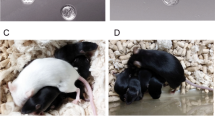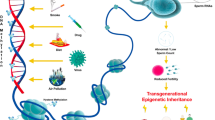Abstract
Purpose
To establish the phenotype of reproductive aging in our mouse model. To test the hypotheses that reproductive aging is associated with a decrease in mitochondrial abundance that could ultimately reflect dysfunction in oocytes.
Methods
Breeding studies were performed in young and aged female virgin wild type C57BL6J mice to establish their reproductive phenotype by measuring time to conception, litter size, and live birth per dam. Individual oocytes were analyzed for mtDNA content. Transmission electron microscopy was used to study ultrastructure of mitochondria in oocytes.
Results
Old females were found to have significantly prolonged time to conception and fewer surviving pups in their litters. Oocytes from old mice had 2.7-fold less mtDNA compared to younger controls (p < 0.001; 95 % CI 2.1–3.5). Decrease in mitochondrial organelle abundance in old animal’s oocytes was confirmed with transmission electron microscopy. Distinct morphological changes were noted in mitochondria, suggesting altered mitochondrial biogenesis in the old animals’ oocytes.
Conclusions
Reproductive aging in mice is associated with reduced reproductive competence. Aging is associated with a significant decrease in number of mitochondria in oocytes. Our data support mitochondrial organelle loss and dysfunction in oocytes as a potential etiology for reproductive senescence.



Similar content being viewed by others
References
Angell R. First-meiotic-division nondisjunction in human oocytes. Am J Hum Genet. 1997;61(1):23–32.
Bentov Y, et al. The contribution of mitochondrial function to reproductive aging. J Assist Reprod Genet. 2011;28(9):773–83.
Chen X, et al. Rearranged mitochondrial genomes are present in human oocytes. Am J Hum Genet. 1995;57(2):239–47.
Cote HC, et al. Mitochondrial: nuclear DNA ratios in peripheral blood cells from human immunodeficiency virus (HIV)-infected patients who received selected HIV antiretroviral drug regimens. J Infect Dis. 2003;187(12):1972–6.
Dalakas MC, et al. Mitochondrial myopathy caused by long-term zidovudine therapy. N Engl J Med. 1990;322(16):1098–105.
Davani EY, et al. Insulin-like growth factor-1 protects ischemic murine myocardium from ischemia/reperfusion associated injury. Crit Care. 2003;7(6):R176–83.
Keefe DL, et al. Mitochondrial deoxyribonucleic acid deletions in oocytes and reproductive aging in women. Fertil Steril. 1995;64(3):577–83.
Kuliev A, et al. Chromosomal abnormalities in a series of 6,733 human oocytes in preimplantation diagnosis for age-related aneuploidies. Reprod Biomed Online. 2003;6(1):54–9.
Lewis W, et al. Mitochondrial ultrastructural and molecular changes induced by zidovudine in rat hearts. Lab Invest. 1991;65(2):228–36.
May-Panloup P, et al. Low oocyte mitochondrial DNA content in ovarian insufficiency. Hum Reprod. 2005;20(3):593–7.
Michaels GS, Hauswirth WW, Laipis PJ. Mitochondrial DNA copy number in bovine oocytes and somatic cells. Dev Biol. 1982;94(1):246–51.
Motta PM, et al. Mitochondrial morphology in human fetal and adult female germ cells. Hum Reprod. 2000;15 Suppl 2:129–47.
Pellestor F, et al. Maternal aging and chromosomal abnormalities: new data drawn from in vitro unfertilized human oocytes. Hum Genet. 2003;112(2):195–203.
Perez GI, et al. Genetic variance modifies apoptosis susceptibility in mature oocytes via alterations in DNA repair capacity and mitochondrial ultrastructure. Cell Death Differ. 2007;14(3):524–33.
Reynier P, et al. Mitochondrial DNA content affects the fertilizability of human oocytes. Mol Hum Reprod. 2001;7(5):425–9.
Santos TA, El Shourbagy S, St John JC. Mitochondrial content reflects oocyte variability and fertilization outcome. Fertil Steril. 2006;85(3):584–91.
Sathananthan AH, Trounson AO. Mitochondrial morphology during preimplantational human embryogenesis. Hum Reprod. 2000;15 Suppl 2:148–59.
Schon EA, et al. Chromosomal non-disjunction in human oocytes: is there a mitochondrial connection? Hum Reprod. 2000;15 Suppl 2:160–72.
Shigenaga MK, Hagen TM, Ames BN. Oxidative damage and mitochondrial decay in aging. Proc Natl Acad Sci U S A. 1994;91(23):10771–8.
Spurr AR. A low-viscosity epoxy resin embedding medium for electron microscopy. J Ultrastruct Res. 1969;26(1):31–43.
Tachibana M, Sparman M, Mitalipov S. Chromosome transfer in mature oocytes. Nat Protoc. 2010;5(6):1138–47.
Tarin JJ. Potential effects of age-associated oxidative stress on mammalian oocytes/embryos. Mol Hum Reprod. 1996;2(10):717–24.
Van Blerkom J. Mitochondria in human oogenesis and preimplantation embryogenesis: engines of metabolism, ionic regulation and developmental competence. Reproduction. 2004;128(3):269–80.
Van Blerkom J, Davis PW, Lee J. ATP content of human oocytes and developmental potential and outcome after in-vitro fertilization and embryo transfer. Hum Reprod. 1995;10(2):415–24.
Wai T, et al. The role of mitochondrial DNA copy number in mammalian fertility. Biol Reprod. 2010;83(1):52–62.
Wang W, et al. Superoxide flashes in single mitochondria. Cell. 2008;134(2):279–90.
Wilding M, et al. Mitochondrial aggregation patterns and activity in human oocytes and preimplantation embryos. Hum Reprod. 2001;16(5):909–17.
Wilding M, et al. Chaotic mosaicism in human preimplantation embryos is correlated with a low mitochondrial membrane potential. Fertil Steril. 2003;79(2):340–6.
Acknowledgments
These data were presented at the 59th annual Society for Gynecologic Investigation meeting. Supported by DHHS, NIH DA030996 to William Lewis MD. Authors have nothing to disclose
Author information
Authors and Affiliations
Corresponding author
Additional information
Capsule
Reproductive aging in mice is associated with reduced reproductive competence, a significant decrease in number and altered structure of ooplasmic mitochondria.
Rights and permissions
About this article
Cite this article
Kushnir, V.A., Ludaway, T., Russ, R.B. et al. Reproductive aging is associated with decreased mitochondrial abundance and altered structure in murine oocytes. J Assist Reprod Genet 29, 637–642 (2012). https://doi.org/10.1007/s10815-012-9771-5
Received:
Accepted:
Published:
Issue Date:
DOI: https://doi.org/10.1007/s10815-012-9771-5




